by Chad Harris
written for the Hardy Plant Society of Oregon Bulletin
Perhaps no other iris has had so many different names and miscommunication of cultural needs as the legacy of the Japanese iris.
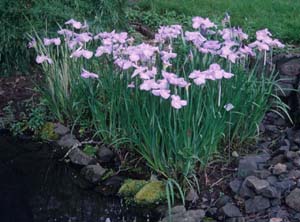
All Japanese iris cultivars are forms of Iris ensata a species found in northern China, Korea, Asiatic Russia, and Japan. Many other garden irises are hybrids between different species, sometimes several. Centuries of Japanese selective breeding with a keen and watchful eye have paved the way with a multitude of colors, color patterns, and flower forms using one species.
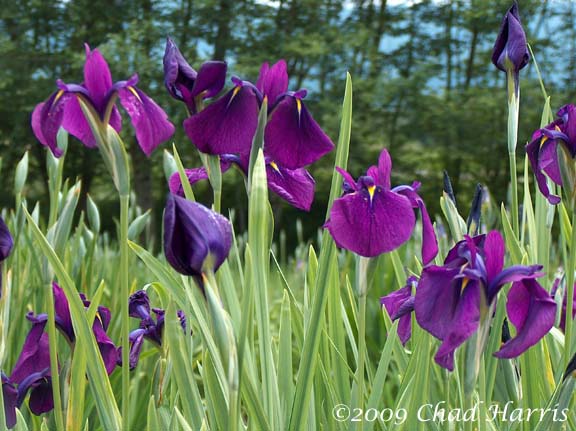
The typical wild Iris ensata grows 36 to 40 inches tall with flower parts the same as every other iris species. Three standards and three falls, the top part and bottom part of the flower respectively. The heart of the flower consists of three style arms and their crests. There is a yellow signal on the fall, this is to direct the pollinator where to land. A typical color Iris ensata is a rich red violet sometimes shading into blue violet; rare indeed would be a pinkish color or a white alba. Mind you that these are not of the width and breath of modern cultivars that can be 8 to 12 inches across, but small 3 to 4 inch blooms. The species and the three distinctive flower forms developed in Japan are known as hanashobu.
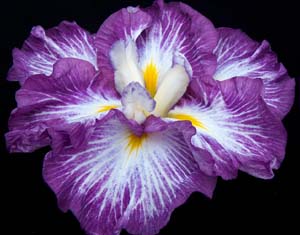
A samurai Sadahiro Matsudaira is the person credited to breaking the mold of this very dominate species flower color, with plants and seed collected from the Asaka marshes north of Edo (now Tokyo). These plants had more varicolored flowers and were more prone to mutate. However, it was his son that changed the flower form.
Sadatomo Matsudaira (1773-1856) continued his father’s work and after several generations Matsudaira obtained a seedling of sufficient importance that, it had six falls (petals) and no standards, what we now call a double bloom. Breeding for larger sized flowers Matsudaira obtained a multi-petal flower of nine falls with a peony form that he named ‘Uchu’ which means universe. Today it is still grown in Japan and revered as much as the man who created it. These plants with their striking blooms of many colors and color patterns are called Edo type for the city in which father and son lived. They were and still are grown in park like settings and gardens in the ground as permanent plantings for people to enjoy in and out of bloom, not unlike the planting at our own Portland Japanese Garden.
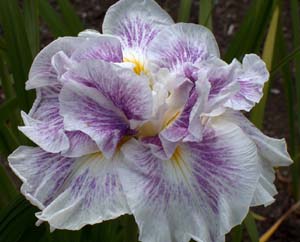
Sadago Yoshii (1776-1859) who lived in Ise had his own idea of the perfect flower. Thinking that a six fall bloom was a monstrosity one can only imagine what he thought of the multi-petal peony form. His breeding program dictated that the single (three falls) flower should be soft pastel in color with no garish patterns. In addition the flower should flutter with the breeze. To achieve this, Ise flowers, usually have little substance to them and are easily damaged by adverse weather. To show them the plants were grown in pots and brought indoors during bloom to enjoy. A very strict ceremony of viewing evolved with the placement and number of plants. The twenty seven plants were placed in three rows of nine plants in front of a screen.
A third style of Iris ensata was perfected in the Higo prefecture now known as Kumamoto. In the mid 1800’s Narimori Hosakawa lord of Higo spent time in Edo and admired the work of Matsudaira. He then arranged for a number of cultivars to be brought back home to grow and hybridize. Like the Ise, the Higo samurai had their own idea of perfection. The plants were hybridized and grown for the one perfect bloom. Plants that showed a tendency to branch with extra blooms were discouraged. The bloom shape was to mimic the symmetrical outline of Mt. Fuji with wide strong falls. The standards and styles with their crest were also to have a strong outline with precise placement. To show this one perfect bloom the plants were grown in pots and placed indoors in front of a gold colored screen.
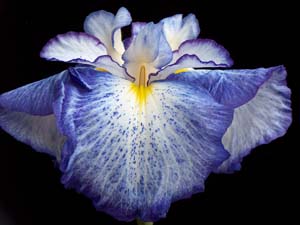
The three separate groups today still have some hybridizers that are working to improve them. While others are using the better qualities and blending by interbreeding and the differences that distinguished them have become less sharp.
The western name mishap started in the 1850’s when Phillip Franz Von Siebold brought plants of the Edo back to Belgium. There he wrote and published a description and named it Iris kaempferi. Unknown to him 50 years prior a simpler form of the species had already been collected, described and named Iris ensata by Carl Peter Thunberg. Although it is improper you can still find Iris kaempferi being used notably in the nursery trade.
To add to this confusion Walter Marx of Boring, Oregon in the 1950’s imported Higo varieties of Iris ensata from Japan. The seedlings that he introduced to the United States with his color catalogs he named Marhigo. I still have a person that comes to our farm during bloom asking for Marhigo plants.
The general public also confuses Iris laevigata the water iris from Japan and siberian hybrids with Iris ensata. Thinking that if it has grassy foliage and a large flat bloom then it must be a Japanese iris.
Iris ensata has had its highs and lows with the American gardener. I personally find it interesting that in the early 1900’s Iris ensata was the most popular iris for the garden, even more so than bearded. With the event of World War II anything with ties to Japan lost favor with the American public.
Recently Iris ensata has seen a recurrence in the nursery trade and more people are rediscovering the great beauty that Iris ensata can bring to the garden with proper culture.
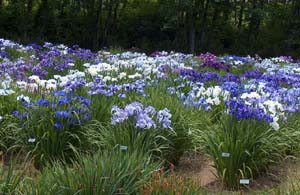
Many think of ponds when asked about Iris ensata. It is true that during bloom some gardens in Japan flood the plants; however that is only for esthetic purposes. In truth if the crown of Iris ensata is underwater too long, it will drown. Iris laevigata an equally beautiful plant and bloom is a true water iris from Asia. Iris ensata is naturally found growing on the banks of ponds or marsh meadows, where the soil is always moist. In the garden this can be achieved by deep watering once a week, as we do, with 2 to 4 inches of water.
The soil must be loose, rich in humus compost and slightly acidic. Mulch on top of the soil will help to retain moisture and help keep the soil from compacting.
A sunny site with a full day’s sun is preferred, with afternoon shade in a hot enclosed area.
If these criteria are met Iris ensata will reward you with a very robust grass like plant about waist high. The bloom stems carry 2 to 7 buds and are typically 38′” to 42″, but can reach 48″ plus. The blooms range in size from 6″ to 8″ across to monster 10″ to 12″, Many with sharp contrasting patterns in a full color spectrum range of red violet to blue violet.